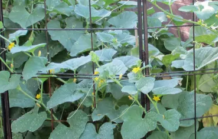https://hnr.k-state.edu/extension/info-center/newsletters/index.html
Blog Post: http://www.ksuhortnewsletter.org
Video of the Week: Cuttings to Grow Inside for the Winter
https://kansashealthyyards.org/all-videos/video/cuttings-to-grow-inside-for-winter
Events
Kansas Forest Service Tree, Shrub Seedling Sale, September 1 – October 15
Orders can be placed starting September 1st and will continue until stock runs out or October 15th.
Select your preferred shipping date during check-out or pick-up is available on Fridays.
https://kfs.mybigcommerce.com/
K-State Garden Hour Webinar Series
https://hnr.k-state.edu/extension/info-center/k-state-garden-hour-webinar-series/k_state_garden_hour.html
REMINDERS
• Fertilize cool-season lawn (Kentucky bluegrass or tall fescue) if haven’t done so yet.
• Dig gladiolus when foliage begins to yellow and air dry before storing.
• Buy spring-flowering bulbs while selection is good. Plant in late September through October
TURFGRASS
Lawn Seeding Best Done in September
September is the best month to reseed cool-season lawns such as tall fescue and Kentucky bluegrass. See the August 23 newsletter for information on how to seed or overseed. We usually recommend not planting Kentucky bluegrass past early October. However, you can get by with an early to mid-October planting for tall fescue. October 15 is generally considered the last day for safely planting or overseeding a tall fescue lawn in the fall. If you do attempt a late seeding, take special care not to allow plants to dry out. Anything that slows growth will make it less likely that plants will mature enough to survive the winter
Seedings done after the cut-off date can be successful, but the success rate goes down the later the planting date. Late plantings that fail are usually not killed by cold temperatures but rather desiccation. The freezing and thawing of soils heave poorly rooted grass plants out of the ground, which then dry and die. Keeping plants watered will help maximize root growth before freezing weather arrives. (Ward Upham)
VEGETABLES
Harvesting Sweet Potatoes
Sweet potatoes should be harvested no later than the first fall freeze because cold temperatures can damage the sensitive roots. However, you may want to harvest earlier than this. Test dig a hill to see if they are the size you want.
Sweet potatoes should be cured after being dug. The digging process often damages the tender skin, and curing helps these small wounds heal. Place the roots in a warm, humid location for 5 to 10 days immediately after digging. A location with a temperature around 85 to 90 degrees is ideal. A space heater can be used to heat a small room or other area. Raise the humidity by placing moist towels in the room. The curing process not only heals wounds but also helps convert starches to sugars. This process improves the texture and flavor of the roots.
Sweet potatoes should be stored above 55 degrees. Storage at temperatures below that injures the roots, shortens storage life and gives them an off flavor. (Ward Upham)
Rotation of Vegetable Crops
Rotating vegetable crops is a standard way of helping prevent disease from being carried over from one year to the next. Rotation means that crops are moved to different areas of the garden each year. Planting the same crop, or a related crop, in the same area each year can lead to a build-up of disease. Also, different crops vary in the depth and density of the root system as well as extract different levels of nutrients. As a rule, cool-season crops such as cabbage, peas, lettuce and onions have relatively sparse, shallow root systems and warm-season crops such as tomatoes, peppers and melons have deeper, better developed root systems. Therefore, it can be helpful to rotate warm-season and cool-season crops.
As mentioned earlier, it is also a good idea to avoid planting closely related crops in the same area as diseases may be shared among them. For example, tomatoes, potatoes, peppers and eggplant are closely related. Also, broccoli, cauliflower, cabbage and brussels sprouts share many characteristics in common. For example, do not plant cabbage where broccoli was the previous year or tomatoes where the peppers were.
So, why is this important to bring this up in the fall? Now is the time to make a sketch of your garden so that the layout is not forgotten when it is time to plant next year. (Ward Upham)
ORNAMENTALS
Plants and Lacebug Damage
We are seeing oak and sycamore leaves browning or bronzing due to lacebug damage. Other plants that may be affected include hawthorns, cotoneaster and pyracantha. Lacebugs are very small insects with wings that resemble lace under magnification. All stages of the insect develop on the undersides of leaves where they suck the sap. Adults are about 1/8 inch long. Under heavy infestations, stippling damage becomes evident. The leaves lose their green color, becoming pale and often show a bronze color. The undersides of the leaves may become speckled with brownish black excrement spots and cast nymphal skins.
Healthy plants will not be damaged by lacebug this late in the season. The trees and shrubs had plenty of time during the spring and summer to make the food needed to survive the winter. Control measures are not recommended. (Ward Upham)
Ornamental Sweet Potatoes
We often receive the question as to whether ornamental sweet potatoes are safe to eat. The answer is yes. Note that they are chosen for ornamental qualities rather than flavor and so may not have the quality nor the nice shape of our traditional types. See the accompanying article on how to cure them. (Ward Upham)
MISCELLANEOUS
Garden Spiders
People may become concerned when they see a large, noticeable spider setting up shop in or near the garden. These garden spiders feed on insects and are considered beneficial.
There are actually two common species of garden spiders in Kansas that are active during the day. The yellow garden spider has a black abdomen with yellow to yellow-orange markings. The black legs have a yellow or reddish band.
The banded garden spider has numerous bands on both the abdomen and legs. Those on the abdomen are alternating white and dark bands. The legs have alternating black and orange bands. Both of these spiders are orb weavers that spin large webs with the typical spider web shape.
Though these garden spiders have poor eyesight, they are extremely sensitive to vibrations that pass through the web and use this sensitivity to capture their prey. Since these spiders are beneficial and harmless to humans, it is recommended that they be left alone. (Ward Upham)
Contributors: Ward Upham, Extension Associate
Division of Horticulture
1712 Claflin, 2021 Throckmorton
Manhattan, KS 66506
(785) 532-6173
For questions or further information, contact: wupham@ksu.edu OR cdipman@ksu.edu
This newsletter is also available on the World Wide Web at:
http://hnr.k-state.edu/extension/info-center/newsletters/index.html
The web version includes color images that illustrate subjects discussed. To subscribe to this newsletter electronically, send an e-mail message to cdipman@ksu.edu or wupham@ksu.edu listing your e-mail address in the message.
Brand names appearing in this newsletter are for product identification purposes only. No endorsement is intended, nor is criticism implied of similar products not mentioned.
K-State Research and Extension is committed to making its services, activities and programs accessible to all participants. If you have special requirements due to a physical, vision or hearing disability, or a dietary restriction please contact Extension Horticulture at (785) 532-6173.
Kansas State University Agricultural Experiment Station and Cooperative Extension Service K-State Research and Extension is an equal opportunity employer. Issued in furtherance of Cooperative Extension Work, Acts of May 8 and June 30, 1914, as amended. Kansas State University, County Extension Councils, and United States Department of Agriculture Cooperating, Ernie Minton, Dean.





